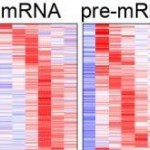Gene Expression
On Pharyngula, PZ Myers criticizes the stubborn obfuscations of Michael Behe, who refuses to yield his illogical calculations. Behe says (rightly) that a certain mutation necessary for drug resistance in the malaria parasite has about a 1 in 1020 chance of occurring. But the mutation is also detected in 96% of malaria patients who respond well to the drug; it proliferated widely because, by itself, it had no impact on the parasite's fitness. The parasite needed another mutation, occurring at a later date, to develop resistance to the drug. Behe rests his case for divine intervention on the…
A somewhat accidental discovery and random meetings between proteins in a cell: These are the subjects of two new online articles. Each, it its way, involves a technological advance that will, in turn, lead to further scientific discovery.
The first involves a partnership between a physics group and a cancer-research group. Among other things, such collaboration is essential for dealing with large data sets - multiple gene expression patterns, for example. When the team made their discovery, they were looking not just at gene expression, but at pieces of genes. More precisely, they were…
Disease Gene Characterization through Large-Scale Co-Expression Analysis:
Celsius, the largest co-normalized microarray dataset of Affymetrix based gene expression, was used to calculate the correlation between all possible gene pairs on all platforms, and generate stored indexes in a web searchable format. The size of Celsius makes UGET a powerful gene characterization tool. Using a small seed list of known cartilage-selective genes, UGET extended the list of known genes by identifying 32 new highly cartilage-selective genes. Of these, 7 of 10 tested were validated by qPCR including the…
You might think the coolest thing about the Next Generation DNA Sequencing technologies is that we can use them to sequence long-dead mammoths, entire populations of microbes, or bits of bone from Neanderthals.
But you would be wrong.
Sure, those are all cool things to do, but Next Generation DNA sequencing (or NGS for short) can give us answers to questions that are far, far more interesting.
With NGS, we can look at entire transcriptomes (!!) together with the proteins that make them and the DNA modifications that help regulate them. If we compare a cell to music, a genome sequence…
The New England Journal of Medicine has a series of articles up on the impact of new genomic techniques on medicine, specifically in the domain of pinpointing genetic markers which are correlated with increased risk of a particular disease. David Goldstein has a skeptical take up on the future returns of genomewide association studies, while Joel Hirschhorn is more hopeful. There is another review which takes a middle path, emphasizing the relatively marginal predictive power of many of the risk alleles, but suggesting that techniques and results are bound to improve.
Probably the most…
